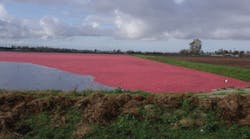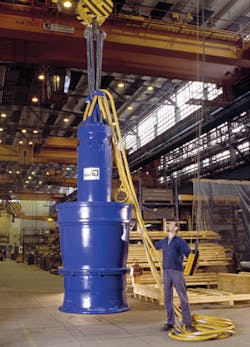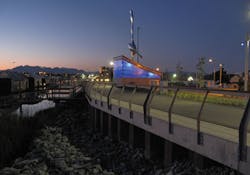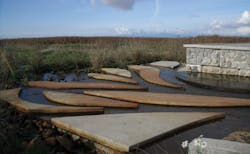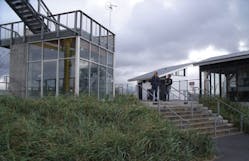The City of Richmond is Canada's largest cranberry growing area. Water levels have to be strategically controlled for harvesting, yet these areas also protected from flooding. Operating behind the scenes are 41 pumping station, providing a total pumping capacity of 85 m3/second. A further $50 million investment is anticipated over the next five years.
By Bryan Orchard
The City of Richmond, British Columbia, Canada occupies 129.66 sq.km over 15 islands in the Fraser River delta. With a natural average elevation of 1.0 metres above mean sea level, flooding has long been a major concern.
The largest and most densely populated of the islands is Lulu Island, followed by Sea Island, home to Vancouver International Airport. Over the years many areas of the City have been raised out of the flood plain through land development land improvements. Through a continuing programme of dike construction and the installation of pumping stations, Richmond's efforts have prevented significant flooding in the community for over 60 years.
The challenge that faces the City of Richmond is rather unusual with occupancy and use being split between residential/commercial and agricultural activities. It is Canada's largest cranberry growing area and at harvest time in the Fall the fields have to be flooded. However, at the same time it is necessary to keep water levels down in the drainage channels so that other parts of the island do not flood. It is a delicate balancing act that combines irrigation, drainage and flood control.
"The City of Richmond and its funding partners have spent $45 million since 2008 on flood protection measurements and an additional $50 million investment over the next five years is being recommended," reports Romeo Bicego, manager, sewerage and drainage engineering and public works.
"Over the past five years, 4.4 kilometres of dikes have been or are scheduled to be raised to between 4.0 and 4.7 metres above average sea level, exceeding current provincial requirements. Also, 10 drainage pump stations have been rebuilt to improve capacity. The City secured funding to help offset its investment in these projects and spent $9.9 million on drainage and dike improvements throughout 2014."
Pumping station investment
The City of Richmond operates 41 pumping stations, providing a total pumping capacity of 85 m3/sec, and currently there is a programme of new build and reinvestment being undertaken, with KSB's submersible pumps being the preferred equipment.
Maintenance is high on the Engineering and Public Works' agenda as it is far more cost effective to invest in maintenance than replace products.
"We spend considerable effort on maintaining our pumping stations and there is a staff of 18 dedicated to checking that the stations are clean, odours are controlled and intake screens are free of debris," he comments. "The last thing we want is for the pumps just to be cycling water. Through previous storm events we know that we can experience 30-50mm of rain, so we need to ensure that screens are free of blockages ahead of predicted storms."
Located at strategic intervals around the island, the pumping stations are called into service as and when required, and all are fitted with flood gates and flood boxes. However, during the winter months, the pumping stations are called into to action much more frequently.
Groundwater levels can be very high during the winter and this is exacerbated when there is heavy rainfall and tides are high. At high tides, the pumps transfer drainage water into the Fraser River Delta and at low tide drainage water discharges through the flood boxes via gravity outflow gates.
One of the other main aspects that have to be taken into account is the possibility of power outages. The city's goal is to have all the stations equipped with stand-alone generators. Currently there are 11 on site generators and 10 portable sets.
Design considerations
In order for the new and refurbished pumping stations to have the minimum visual impact on the environment, Richmond gives a great deal of thought into their design and construction. This policy has been rewarded. The Cambie Pumping station, located in a light industrial area close to a residential development on the Fraser River, won a design award.
Having a vegetation- covered roof to blend in with the environment, the station is built into the dike affording walkers a rest and comfort stop facility along the river. Not content with this, there is an impressive sculpture by the pump house designed to resemble a droplet of water. Elsewhere, the No 4 Road pumping station is located in a former industrial area that is currently going through a residential transition. Converted from a long shaft pump station, the design has incorporated aspects of the old station, together with the crane lifting frame which now acts as a viewing platform.
The walls of the pump house depict historical scenes of the lumber business along the Fraser River and the standby power generation plant is visible though clear glass walls. By deliberately making the pumping station both visually attractive, practical and a community amenity, vandalism is deterred.
Consideration is also given to the outflow from the pumping stations. As large volumes of water can lead to the erosion of river banks, creeks and beaches, spillways are designed to minimise impact where this is a problem.
Forward planning
Designed for a one in ten year rainstorm the pumping stations are all monitored remotely 24-hours a day using SCADA to ensure the pumps are operating effectively. This provides additional capacity to hold the surplus drainage water resulting from a storm. While risk profiles with climate change and sea level rise are changing slowly, the City's flood protection improvements are moving faster and the overall level of safety keeps improving.
"We are constantly looking at sea levels and dike heights and where development is taking place we work with developers to raise the height of dikes. This can involve advising them on the height of the foundations and ensures that the properties are built into the dikes," continues Bicego.
Beginning in 2015, City staff will propose another $50 million to be spent over the next five years. This will target five pump station rebuilds, 10 drainage upgrades and $7 million worth of dike upgrades. The City will continue to aggressively pursue funding from senior levels of government and other partners to support these projects. New development along the City's waterfront is also contributing to improving Richmond's dikes.
The new build programme is delivering one new station a year and KSB Canada is involved in working with the project engineers in the design of the water intake and the tubes. Nine of the stations already completed use KSB submersible pumps, and in total 28 pumps have already been commissioned, these being twenty-four 127hp and four 37hp units.
Romeo says: "There is a high iron content in the water, but this has not proved to be a problem for these pumps. We like to keep one pump in our workshops as a standby and we do maintain comprehensive stocks of spares."
The Amacan P is a close-coupled, wet-installed single entry axial open impeller pump where the impeller is located in a tubular casing immersed in the water. Explosion protected to ATEX II G2 T3, the pump has a maximum flow capacity of up to 7 m3/sec and a maximum head of 12m.
Low vibration hydraulics and a vortex-free flow due to the inlet ribs and wide bellmouth ensure that the pump is hydraulically optimised. Operating efficiency is provided by the slim motor that minimises discharge tube flow losses.
When it comes down to specifying pumps, Bicego emphasises the importance of standardisation.
"By standardising on a single type of submersible pump, we have been able to focus our product training and knowledge on this pump, which makes maintenance far more cost effective."
The City is also developing a long-term Dike Master Plan. Phase one of the plan has been completed and it further proposes an innovative solution to move the outer perimeter of the City's southwest dike onto unoccupied Steveston Island.
"This will provide both enhanced flood protection and lessen dredging requirements in Steveston Harbour, Canada's largest commercial fishing harbour, while preserving heritage and other structures built on the existing dike," says Bicego.
In addition, a number of other dike and drainage projects and works to provide flood protection are to be undertaken. These will address new provincial seismic standards, support the viability of Richmond's agriculture and marine industries and address environmental concerns, such as the erosion of Sturgeon Banks and rainwater management.
Bryan Orchard is freelance contributor specialising in pumps and provided this article on behalf of KSB. Email: [email protected]
More Water & WasteWater International Archives Issue Articles

